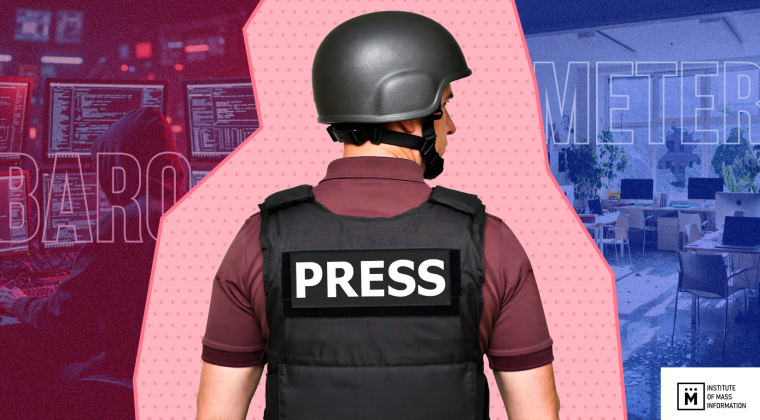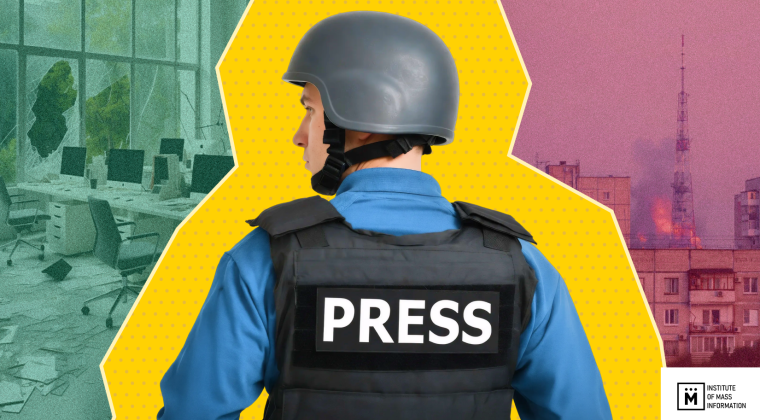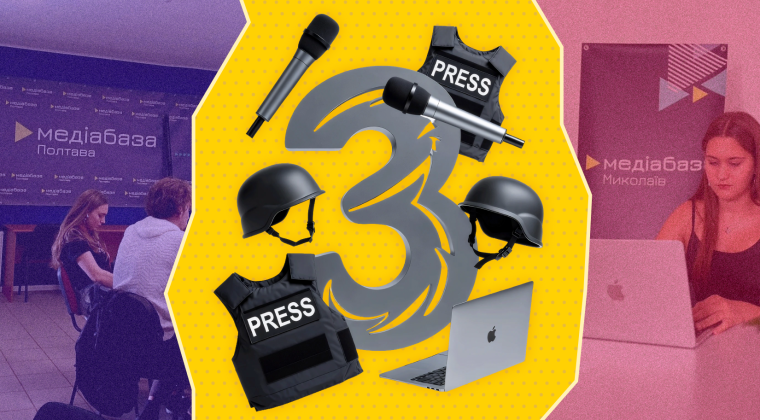In the two years of their occupation, Russian invaders have either destroyed or ‘Russified’ all Ukrainian media outlets operating in the temporarily occupied regions of Ukraine, affecting at least 300 editorial offices in the Zaporizhzhia, Kherson, and Luhansk regions. Only a handful of these offices managed to relocate and resume operations in other regions. The majority were either shut down or seized by Russian occupiers.
In the occupied territories, Russian forces selectively switch on and off mobile communications and the Internet, fearing that locals might relay information to Ukrainian defence forces. Since September 2022, residents of these areas have found themselves in an information vacuum, effectively isolated from the rest of the world. In certain locations, access to the Internet is completely unavailable. The information vacuum is exacerbated by the closure of certain settlements. Some can only be entered with a special pass.
During the first six months of the full-scale war, Russian forces systematically eradicated all elements associated with Ukrainian and Western media in the occupied territories. Moreover, they repurposed seized transmitters to disseminate Russian propaganda through TV and radio channels, and initiated the distribution of propaganda leaflets glorifying the ‘great Russian struggle against European fascism and Satanism’. By 2023, the Russians started establishing a local network of information resources in these regions. This network now boasts an extensive array of Telegram channels, television and radio) stations, and websites that perpetually spread aggressive disinformation, propagate extreme hate speech, and incite calls to war. Additionally, the occupiers have granted residents of the temporarily occupied territories free access to the ‘Russkiy Mir’ satellite TV channel. All these efforts are financed by the Russian federal budget.
How the Russian occupiers destroyed Ukrainian media in occupied regions
In the first days of the occupation, armed military personnel simply showed up at local media offices in the occupied territories to intimidate journalists and force them to work for the Kremlin. However, almost all local Ukrainian media and journalists refused to work for the enemy. As a result, media outlets were closed down after facing enormous pressure, or Russian occupiers seized their editorial offices and appropriated their property. Punitive measures against journalists began in the first weeks of the occupation. The Russian invaders had pre-compiled lists of the personal data of civic activists and journalists who worked in the occupied territories and were purposefully looking for them. According to Reporters Without Borders, many Ukrainian and several foreign journalists reported the persecution of journalists and other people at the beginning of the full-scale invasion and the occupation of the Zaporizhzhia region.
All journalists who were unable to evacuate faced significant risks. For instance, Oleg Baturin, a journalist from Kherson who reported on the occupation of the Kherson region at the start of the full-scale invasion, was abducted, tortured, and detained by Russian forces. Similar acts of abduction, beatings, and intimidation were reported in the Zaporizhzhia, Kharkiv, and Luhansk regions. The Institute of Mass Information has documented at least 40 such instances. Currently, over 20 journalists remain in Russian captivity. The status of Iryna Levchenko, a journalist from Zaporizhzhia detained by the occupiers in May 2023 in occupied Melitopol, is still uncertain.
The occupiers continue to persecute Ukrainians working in the occupied territories. For example, in August 2023, the Russian occupiers hacked the Telegram channel of the Ukrainian media outlet RIA Melitopol, which operated in the temporarily occupied territory. At the same time, the occupiers detained the channel’s administrators. They are now being charged under several articles of the Russian criminal code, including making public calls for terrorist attacks, high treason, and espionage, and face 12 to 20 years in prison. The propagandists made a show out of this detention by publishing a video of it on Russian state channels two months after the event. The current whereabouts of these administrators, who are Ukrainian journalists, remain unknown.
This aggressive approach has led to the complete and tightly controlled Russification of the media landscape in the temporarily occupied territories over the two years of the full-scale invasion.
How the Russian occupiers built a propaganda network
Most Russian media outlets currently active in the temporarily occupied territories are affiliated with Aleksandr Malkevich’s propaganda media holding ‘ZaMedia’, established by the occupation administration under the direct guidance of officials from Moscow and St. Petersburg. Initially, the occupiers aimed to make Kharkiv the hub for their propaganda operations, with plans to expand into Kherson. However, their failure to secure these key cities in eastern and southern Ukraine led them to establish their base in Melitopol, a city in the Zaporizhzhia region under occupation. Aleksandr Malkevich is a Russian national with a significant background in crafting propaganda, disinformation, and influencing elections both within Russia and abroad. His activities have drawn international condemnation, resulting in sanctions by the US in 2018 and the EU in 2024. Investigations by Reporters Without Borders have linked Malkevich to the late Yevgeny Prigozhin, a key figure associated with the Wagner private military company. Despite Prigozhin’s presumed death in a plane crash in August 2023, Malkevich continues to expand his influence in the occupied Ukrainian territories, backed by substantial financial support from Russian authorities to further develop networks dedicated to disseminating aggressive propaganda and disinformation.
At the start of the full-scale invasion, the first thing Russian occupiers did was to seize TV towers in the occupied cities and block Ukrainian broadcasting, including TV channels and radio stations. They replaced these outlets with Russian state TV channels in the occupied territories. Later, they seized printing houses and began printing propaganda ‘newspapers’.
The cornerstone of Russian propaganda in the occupied territories is the glorification of everything related to Russia, coupled with defaming and spreading disinformation about Ukraine, the European Union, and the United States. This narrative employs terms like the ‘Kyiv regime’, ‘Nazi’, years of ‘devastation’, and ‘European fascism’, among others. Notably, Russian propaganda carefully avoids any mention of Russia’s full-scale war against Ukraine, preferring instead to speak of ‘liberated’’ territories and ‘internally displaced persons’. This approach effectively crafts an alternate reality detached from the actual context, where the aggressor is recast as the victim and defender, reversing right and wrong.
In 2023, the occupying forces launched a campaign to offer residents of Kherson and other occupied territories complimentary access to the ‘Russkiy Mir’ TV channel, a platform steeped in aggressive propaganda. This channel, initiated in December 2022, targets the Russian-occupied territories across four regions – Donetsk, Luhansk, Zaporizhzhia, and Kherson – and extends its broadcasting to occupied Crimea and Sevastopol. The ‘Russkiy Mir’ project aims to freely disseminate disinformation propagated by Russian state television. It includes 20 mandatory all-Russian public television channels and digital radio channels, alongside regional TV channels from the so-called DPR/LPR, the occupied segments of the Zaporizhzhia and Kherson regions, and Crimea and Sevastopol. This large-scale propaganda project was launched by the ‘All-Russian People’s Front’, a movement to promote Russia that was launched by current Russian President Vladimir Putin in 2011.
The Russian invaders continue to develop a network of Telegram channels in all occupied cities and towns immediately after the occupation. IMI records the largest number of disinformation and propaganda messages in Telegram channels, and they are the most aggressive. They tell local residents that Russia will build direct gas pipelines to their villages, and at the same time scare them with horror stories about Satanists, fascists, ‘Ukrainian rats’, biolabs, and other aggressive fakes that are meant to justify the Russian occupation.
The occupiers also systematically distribute newspapers with huge circulations across the temporarily occupied territory. Sometimes they reach up to 750,000 copies. The most commonly distributed outlet is Komsomolskaya Pravda, funded from the Russian state budget. It is interesting that this publication is prepared by Russian propagandists who came to the occupied territories of Ukraine from different regions of Russia. The content of the newspaper is an alternatively constructed reality. There is not a single word about Russia’s full-scale war against Ukraine, but there is a systematic glorification of Putin and everything related to Russia. At the same time, everything related to Ukraine, the EU, or the US is vilified. In addition, the Russian federal budget and Putin’s foundation – the Presidential Foundation for Cultural Initiatives – provide grants to Russian propagandists. These grants are used to support various initiatives such as the printing of newspapers like ‘Golos Novorossii’ or the creation of the ‘Mediatopol’ media school.
According to the Institute of Mass Information (IMI), in 2023, Russians expanded their propaganda efforts by incorporating foreigners into their operations within the occupied territories. Notably, they invited seven propagandists and so-called experts from countries such as India, Brazil, Mozambique, Spain, Iceland, and the Netherlands to serve as observers during the illegitimate elections in the Kherson region. Almost all of them called themselves journalists.
Propaganda for children
The Russian occupiers are also developing media propaganda projects aimed at school and university students. For example, they have created the ‘School of Young War Correspondents’. And in Luhansk, Russians opened the so-called ‘House of Journalists’, where they have even held a forum for Russian propagandists and are trying to attract young people to study there. In the Kherson region, Andrei Tsitsinov, an employee of the TASS propaganda outlet, held ‘journalism lessons’ where he told local residents that the occupied territories are ‘indigenously Russian’.
For children and young people, Russians are conducting a number of militarisation activities and promoting aggressive propaganda. According to IMI, in occupied Luhansk, in a building of the Luhansk College of Car Service, Russians promise to open a branch of the ‘Military and Sports Training Centre, “Warrior”’. The ‘centre’ will be staffed by ‘experienced instructors’, and the main audience, according to the occupiers, will be young people aged 14-35. They will be trained in eight military areas. The occupiers do not specify which areas. The occupiers also bring teachers from Russia to the Luhansk region to teach local children the ‘correct’ curriculum.
***
According to the Institute for the Study of War (ISW), Russian authorities are initiating plans to establish a media conglomerate named New Regions within the occupied territories of the Zaporizhzhia region, backed by the Russian federal government. This conglomerate is set to collaborate with media projects across all occupied territories of Ukraine, representing just one facet of the extensive propaganda initiatives currently operational in these areas.
Institute of the Mass Information expert Natalia Vygovska for EUvsDisinfo



